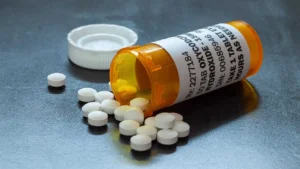Percocet, a prescription painkiller composed of oxycodone and acetaminophen, is often prescribed for moderate to severe pain but carries a high risk of addiction. When dependence forms, the path to recovery begins with a proper detox process. This guide aims to shed light on the Percocet detox journey, providing essential information to help individuals and their loved ones understand what to expect and how to prepare for the challenges ahead.
Contents
Is Percocet the Same as Oxycodone?
 Percocet is not the same as oxycodone, though it contains oxycodone as one of its primary ingredients. Specifically, Percocet is a combination medication that includes both oxycodone. This is a powerful opioid pain reliever, and acetaminophen, which is a less potent pain reliever used to enhance the effects of oxycodone. This combination is intended to provide more effective pain relief than either component alone.
Percocet is not the same as oxycodone, though it contains oxycodone as one of its primary ingredients. Specifically, Percocet is a combination medication that includes both oxycodone. This is a powerful opioid pain reliever, and acetaminophen, which is a less potent pain reliever used to enhance the effects of oxycodone. This combination is intended to provide more effective pain relief than either component alone.
Oxycodone, on the other hand, can be prescribed alone as a single-ingredient opioid medication under various brand names, including OxyContin. Unlike Percocet, which is typically prescribed for moderate to severe short-term pain. Patients and caregivers need to understand the differences between these medications, especially regarding their potential for addiction and the appropriate uses for each.
When Is Percocet Detox In Necessary?
Percocet detox becomes necessary when an individual has developed a physical and possibly psychological dependence on the medication. This dependence is typically characterized by the need to continue using Percocet to avoid unpleasant withdrawal symptoms and to function normally. Here are key indicators that suggest a detox may be needed:
- Tolerance Development: If you notice you need to take larger doses of Percocet to achieve the same pain-relieving effects, this could be a sign of developing tolerance, a key indicator of dependence.
- Withdrawal Symptoms: Experiencing withdrawal symptoms such as restlessness, sweating, chills, irritability, anxiety, and flu-like symptoms when not taking the drug is a strong sign that your body is dependent on Percocet.
- Inability to Stop Using: If you’ve tried to stop or reduce your Percocet use but find yourself unable to do so, this indicates a dependence that might require professional detox.
- Impact on Daily Life: If the use of Percocet is affecting your personal, professional, or social life, detox and treatment might be necessary to regain control.
- Compulsive Usage: Engaging in compulsive drug-seeking behavior, such as doctor shopping or using Percocet in a way not prescribed, is a red flag that detox and further intervention are needed.
Detox is a critical first step in the recovery process. This aimed at safely managing withdrawal symptoms under medical supervision, setting the stage for effective rehabilitation and therapy.
How To Do Percocet Detox?
 Detoxing from Percocet should ideally be done under medical supervision to manage the risks and discomfort associated with withdrawal. Here’s a comprehensive outline of how to approach a Percocet detox:
Detoxing from Percocet should ideally be done under medical supervision to manage the risks and discomfort associated with withdrawal. Here’s a comprehensive outline of how to approach a Percocet detox:
1. Consult a Healthcare Professional
Before starting a detox, it’s crucial to consult with a healthcare provider who can assess your specific needs. They will help determine the level of care required, considering factors such as the duration of use, dosage, and any co-existing medical or psychological conditions.
2. Choosing the Right Detox Setting
Depending on the assessment, detox can be done in various settings:
- Inpatient Detox: Provides 24-hour medical supervision in a hospital or specialized detox center. This is recommended for those with severe addiction or those who might experience intense or dangerous withdrawal symptoms.
- Outpatient Detox: Suitable for individuals with mild to moderate dependency. Outpatient detox allows patients to live at home while attending treatment sessions and regular check-ups.
3. Medication-Assisted Treatment (MAT)
Medications can be used to manage withdrawal symptoms and reduce cravings. Common medications include:
- Methadone: Helps ease withdrawal symptoms and facilitate a smoother detox.
- Buprenorphine: Often administered with naloxone (Suboxone), it reduces cravings and withdrawal symptoms.
- Clonidine: Primarily used to reduce anxiety, agitation, and muscle aches.
4. Supportive Care
Support from healthcare providers, counselors, and support groups is essential. Psychological support can help address the emotional and behavioral aspects of addiction.
5. Therapy and Counseling
Engaging in individual or group therapy to address underlying issues that contribute to addiction.
6. Aftercare Planning
Detox is just the first step in addiction treatment. Effective aftercare is crucial to prevent relapse and may include ongoing therapy, support groups like Narcotics Anonymous, or continued medication-assisted treatment.
7. Emergency Planning
Have a plan for medical emergencies. Withdrawal can sometimes lead to severe symptoms like seizures or severe dehydration, which require immediate medical attention.
Percocet detox can be challenging, but with the right approach and support, recovery is achievable. It’s important not to attempt detox alone, especially due to the potential severity of withdrawal symptoms and the risk of relapse.
How Can I Detox Percocet Naturally?
Detoxing from Percocet naturally at home is possible for those with mild dependence. However, it’s crucial to first consult with a healthcare professional to ensure safety. Here are some guidelines for a natural detox process:
- Gradual Tapering
Instead of stopping Percocet abruptly, gradually reduce the dosage according to a plan devised by your healthcare provider. This helps minimize withdrawal symptoms and makes the detox process more manageable.
- Hydration and Nutrition
Drink plenty of fluids to stay hydrated and help flush out toxins. Eating a balanced diet rich in fruits, vegetables, and lean proteins can support your body’s healing. Avoid caffeine and sugar, which can exacerbate anxiety and energy fluctuations.
- Exercise
Engaging in regular physical activity can boost endorphin levels, which helps alleviate depression and anxiety associated with withdrawal. Exercise also promotes better sleep and overall physical health.
- Rest and Sleep
Adequate sleep is crucial during detox, as it allows the body to heal and restore itself. Create a restful environment and maintain a regular sleep schedule.
- Support Systems
Leverage support from friends, family, or support groups like Narcotics Anonymous. Sharing your experiences and challenges can provide emotional relief and valuable guidance.
- Mindfulness and Relaxation Techniques
Practices such as meditation, yoga, and deep breathing exercises can help manage stress and reduce the intensity of withdrawal symptoms.
- Herbal Supplements and Vitamins
Some natural supplements may help manage withdrawal symptoms. For example, Melatonin for sleep issues. Magnesium to help with muscle aches and sleep. Vitamin C, B vitamins, and Zinc to support overall health and recovery.
- Prepare for Withdrawal Symptoms
Be ready to handle symptoms like anxiety, irritability, fatigue, nausea, and sleep disturbances. Understanding these are temporary can help you stay committed to detox.
Remember, while natural home detox methods can be beneficial for some, they are not suitable for everyone, especially those with severe addiction or health complications. Regular check-ins with a healthcare professional are essential to ensure safety throughout the detox process.
How Long The Timeline Is For Detox?
 The timeline for Percocet detox can vary depending on several factors, including the duration and intensity of use, the individual’s metabolism, body composition, and overall health. Generally, the process follows a predictable pattern:
The timeline for Percocet detox can vary depending on several factors, including the duration and intensity of use, the individual’s metabolism, body composition, and overall health. Generally, the process follows a predictable pattern:
- Onset of Withdrawal Symptoms: Symptoms can begin as early as a few hours after the last dose. For most people, they start within 8 to 12 hours after discontinuation.
- Peak Intensity: Withdrawal symptoms typically peak within 48 to 72 hours after stopping Percocet. This is when symptoms are at their most intense and uncomfortable.
- Duration of Acute Withdrawal: Acute withdrawal symptoms usually last for about 4 to 7 days. During this time, physical symptoms such as muscle aches, sweating, gastrointestinal upset, and flu-like symptoms are common.
- Subacute Withdrawal Phase: Following the peak, the intensity of symptoms gradually decreases over the next few weeks. This subacute withdrawal phase can last from a week to two months. During this period, individuals may experience lingering symptoms like mood swings, anxiety, reduced appetite, and disturbed sleep patterns.
- Protracted Withdrawal Symptoms (PAWS): Some individuals may experience a longer-lasting withdrawal phase known as Post-Acute Withdrawal Syndrome (PAWS). These symptoms are generally psychological, such as ongoing depression, anxiety, and sleep disturbances, and can last for months after stopping Percocet.
It’s important to have medical supervision during the detox process, particularly because withdrawal from opioids like Percocet can be extremely uncomfortable. Even, this can sometimes be medically complicated. Professional help can provide necessary support and potentially prescribe medications to manage withdrawal symptoms effectively.
Conclusion
Concluding our comprehensive guide on Percocet detox, it’s crucial to remember that while the journey to recovery can be challenging, it is entirely achievable with the right support and resources. Whether you choose a medically supervised detox, opt for a natural home detox, or require medications to ease withdrawal symptoms, each step towards detox is a step toward regaining control of your life.
Always consult healthcare professionals to tailor a safe and effective detox plan, and remember, persistent support from family, friends, and recovery communities plays an indispensable role in overcoming addiction and maintaining long-term sobriety.
